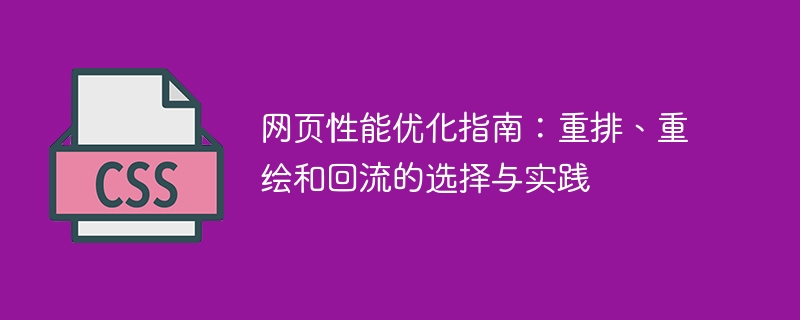

Web page performance optimization guide: selection and practice of reflow, redraw and reflow
With the rapid development and popularity of the Internet, web page performance optimization has become more and more important. an increasingly important issue. A high-performance web page can improve user experience, reduce loading time, and help improve web page rankings. When optimizing web page performance, we often need to face the three concepts of reflow, repaint and layout. This article will provide an in-depth discussion of these three concepts and give specific code examples to help developers choose the appropriate optimization solution.
Reflow refers to the process of the browser recalculating the layout of the web page. When the position, size, or style of a web page element changes, the browser triggers a reflow operation. Reflow is a very expensive operation because it involves recalculating the layout of the entire web page. Therefore, frequent reflows can lead to reduced web page performance.
Redrawing refers to the process of the browser redrawing the web page. When the style of a web page element changes, the browser triggers a redraw operation. Redrawing is less expensive than reflowing because it only involves redrawing part of the web page.
Reflow is a combined operation of reflow and redraw. When the position, size, or style of a web page element changes, the browser triggers a reflow operation. Reflow includes the process of reflowing and redrawing, so its overhead is the largest.
In order to optimize web page performance, we need to avoid frequent reflows, redraws and reflows. The following are some commonly used optimization tips:
The code that causes rearrangement usually includes the following aspects:
In order to accurately locate the code that caused the reflow, we can use the browser's developer tools to detect the number of reflows and the time taken. In the Chrome browser, you can view performance metrics through the Performance panel.
The following are some common code examples that may cause reflow, redraw and reflow:
var element = document.getElementById("element");
element.style.left = "100px";
element.style.width = "200px";var container = document.getElementById("container");
var element = document.createElement("div");
container.appendChild(element);window.addEventListener("resize", function() {
// do something
});
window.addEventListener("scroll", function() {
// do something
});For the above code example, we can perform the following optimizations:
Summary:
Reflow, redraw and reflow are important concepts in web page performance optimization. Understanding these concepts and following the corresponding optimization techniques can greatly improve the performance of your web pages. This article discusses the meaning of reflow, redraw and reflow, and gives specific optimization solutions and code examples, hoping to be helpful to developers in optimizing web page performance. In practice, we can also use some tools and technologies to help us further optimize the performance of web pages, such as using CDN acceleration, compressing and merging static files, lazy loading, etc. Optimizing web page performance is a continuous process, and we need to make adjustments and improvements based on actual conditions.
The above is the detailed content of Optimizing Web Page Performance: A Guide to Choosing and Practicing Reflow, Repaint, and Reflow. For more information, please follow other related articles on the PHP Chinese website!
 direct3d function is not available
direct3d function is not available
 My computer can't open it by double-clicking it.
My computer can't open it by double-clicking it.
 Introduction to software development tools
Introduction to software development tools
 Usage of Type keyword in Go
Usage of Type keyword in Go
 Introduction to the main work content of the backend
Introduction to the main work content of the backend
 Tutorial on buying and selling Bitcoin on Huobi.com
Tutorial on buying and selling Bitcoin on Huobi.com
 How to use countif function
How to use countif function
 What currency is PROM?
What currency is PROM?




